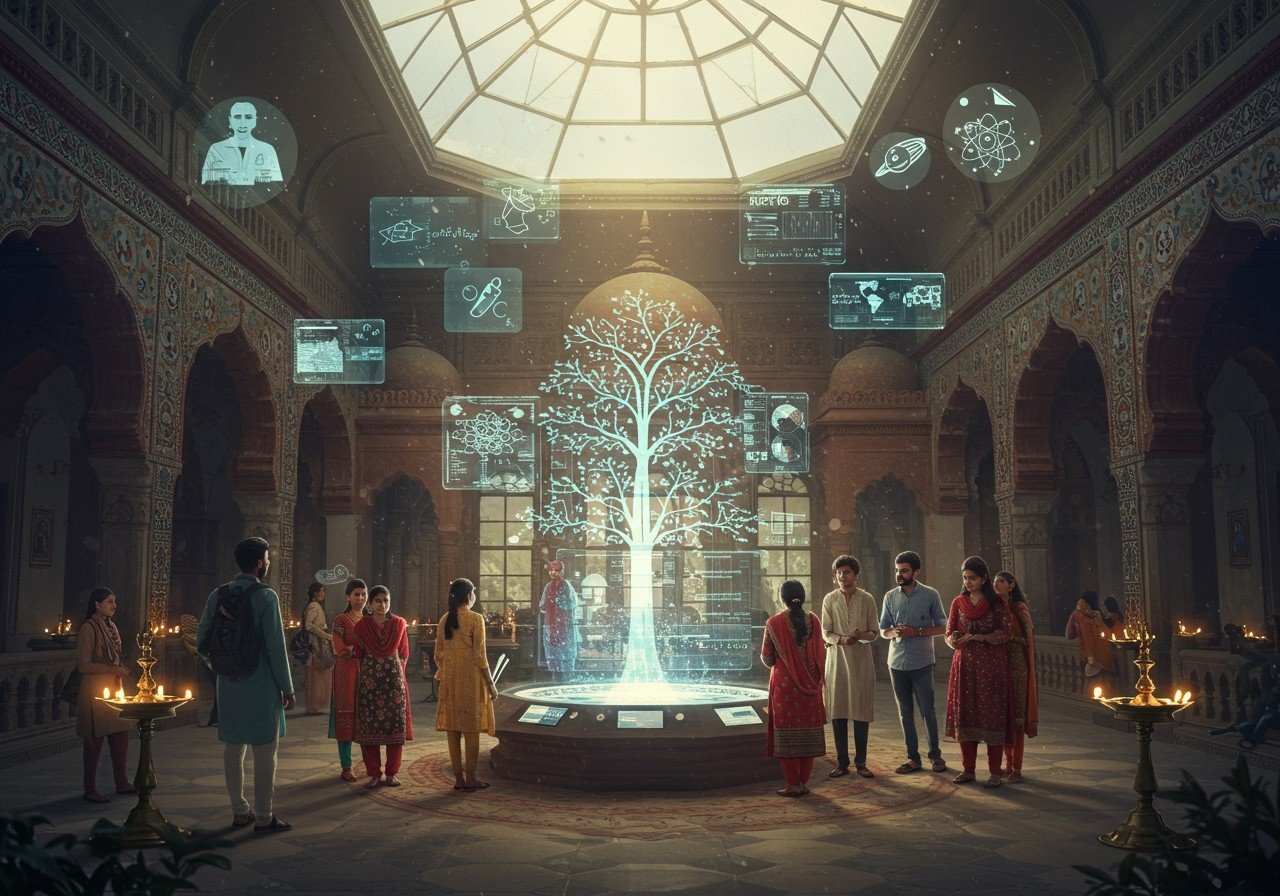
India’s higher education sector has undergone a remarkable transformation, evolving from traditional Gurukuls to the modern institutions we see today. This journey reflects India’s rich socio-cultural heritage and emphasizes the significance of higher education in driving socio-economic progress and national development. Shaped by government policies and global trends, the higher education landscape in India presents unique opportunities and challenges in 2024. Understanding these dynamics is crucial for appreciating the role education plays in shaping India’s future.
Defining Higher Education in India
Higher education in India encompasses universities, colleges, and specialized institutes offering undergraduate, postgraduate, and doctoral programs across a diverse range of disciplines, from humanities and sciences to emerging fields like data science and artificial intelligence. Regulatory bodies such as the University Grants Commission (UGC) and the All India Council for Technical Education (AICTE) play a crucial role in maintaining academic standards. Entrance examinations like JEE, NEET, and UPSC serve as gateways to higher education institutions. These components together define the multifaceted and complex nature of higher education in India.
Current Trends in Higher Education India 2024
India’s higher education system is currently navigating a dynamic period of growth and transformation. As of May 2024, the Gross Enrollment Ratio (GER) stood at 28.4%, with over 4.3 crore students enrolled in approximately 1200 institutions. The National Education Policy (NEP) 2020 sets an ambitious target of achieving a 50% GER by 2035, demonstrating a strong national commitment to expanding access to higher education. Several key trends are shaping the sector:
-
Digital Transformation: The COVID-19 pandemic significantly accelerated the adoption of online learning platforms and blended learning models. This shift has spurred the growth of the Indian EdTech market, projected to reach $30 billion by 2031. Over 70% of schools and universities have integrated digital technologies into their curricula, transforming the way education is delivered and accessed. Explore our collection of puja items related to education and knowledge.
-
Hybrid Learning: Combining the strengths of both in-person and remote learning, hybrid learning is gaining traction and is expected to reach a market cap of USD 325 billion by 2025. This blended approach offers students greater flexibility and convenience, potentially expanding access to higher education for individuals with diverse needs and circumstances.
-
Industry-Academia Partnerships: To better align academic programs with the evolving demands of the workforce, collaborations between industry and academia are increasing. The University Grants Commission (UGC) has revised its guidelines to facilitate these partnerships, enabling institutions to co-create programs with corporations and ensure students graduate with relevant skills and knowledge. You can explore some of our divine idols here.
-
Focus on Skill Development: Addressing the skills gap in the Indian workforce is a national priority. There is a growing emphasis on integrating skill development into the education system. Initiatives such as the Pradhan Mantri Kaushal Vikas Yojana (PMKVY) have provided training to about 20 million young people, equipping them with practical skills and enhancing their employability.
-
NEP 2020 Implementation: The National Education Policy 2020 is being implemented in phases nationwide. This transformative policy emphasizes skill development, flexible curricula, and multidisciplinary education, paving the way for a more holistic and future-ready education system. The NEP also promotes lifelong learning, recognizing that learning is a continuous process that extends beyond formal education.
-
Use of AI: Artificial intelligence (AI) is increasingly being integrated into education, with 58% of university instructors utilizing AI in their work. AI tools are being used to personalize learning experiences, assist faculty with administrative tasks, and provide feedback to learners. This trend has the potential to significantly enhance the efficiency and effectiveness of teaching and learning processes. Get to know about Lord Ganesha here, the remover of obstacles.
-
Research and Innovation: India aspires to become a global knowledge hub. There is a strong push to support research and innovation in higher education. The establishment of the Anusandhan National Research Foundation (ANRF) aims to foster cutting-edge collaborations and increase research funding, driving progress and innovation in various fields.
Opportunities in Higher Education
India’s higher education sector is brimming with opportunities. Government initiatives such as the Rashtriya Uchchatar Shiksha Abhiyan (RUSA) aim to expand access to quality education and improve infrastructure. These efforts also seek to attract international students and faculty, enhancing India’s global standing in higher education.
-
Skill development programs play a crucial role in aligning education with industry needs, improving graduate employability, and meeting the demands of a rapidly changing job market.
-
Increased funding and investment in educational infrastructure create opportunities for growth and improvement in the quality of education provided.
-
Regional and community colleges have the potential to democratize access to higher education, reaching diverse socio-economic groups and ensuring inclusivity. They can provide targeted education and training relevant to local needs.
Challenges Facing Higher Education in India
Despite the positive developments, India’s higher education system faces several challenges that need to be addressed:
-
Low GER: Despite efforts to increase enrollment, India’s GER in higher education still lags behind the global average, indicating that a substantial portion of the population lacks access to higher education.
-
Skills Gap: Many graduates are not adequately prepared for the demands of the job market, indicating a significant skills gap that needs to be bridged through more effective education and training programs.
-
Faculty Shortages: Higher education institutions face a shortage of qualified faculty, which impacts the quality of teaching and research. Attracting and retaining talented educators is crucial for improving educational outcomes.
-
Outdated Curriculum: In many institutions, the curriculum remains outdated and disconnected from the skills required in the 21st-century workplace. Curriculum reform is essential to ensure graduates are equipped with the knowledge and skills needed for success.
-
Funding Constraints: Public spending on higher education in India remains relatively low, leading to a reliance on private institutions. This can create disparities in access and affordability.
-
Brain Drain: Many talented Indian students choose to pursue higher education abroad in search of better opportunities, leading to a brain drain that deprives India of its skilled workforce.
-
Accreditation System: The accreditation system in India needs strengthening. Less than 39% of universities nationwide are accredited, partly due to the high costs involved. Improving the accreditation process can enhance quality assurance and accountability.
How Poojn.in Supports Your Educational Journey
Poojn.in, India’s leading online store for cultural and religious goods, offers a wide selection of puja items and supplies to support students and families seeking blessings for academic success. Our products can be incorporated into traditional rituals associated with education:
-
Saraswati Puja Items: Find complete puja kits to honor Goddess Saraswati, the deity of knowledge and wisdom. These sets include yellow flowers, specific incense, and other traditional offerings.
-
Study Success Kits: Explore curated kits containing items like brass lamps (diyas), pure ghee, and sacred threads (kalawa), traditionally used during exam preparation to invoke positive energy and focus. Tulsi Kanthi Mala is a perfect choice.
-
Yantra and Religious Symbols: Discover sacred geometry tools like the Saraswati Yantra and Vidya Yantra, believed to enhance learning, memory, and concentration. Find natural products here.
-
Pure Copper Items: We offer traditional water vessels and accessories made of pure copper, believed to promote mental clarity and improve learning capacity.
Visit www.poojn.in today to browse our complete collection of education-related puja items. We offer pan-India delivery and guarantee authentic products sourced directly from trusted manufacturers. All items include detailed usage instructions in multiple languages.
Note: Prices and product availability are subject to change. Please check the website for the most up-to-date information.
Conclusion: Embracing the Future of Higher Education in India
India’s higher education sector is on a transformative journey, blending tradition with innovation. The National Education Policy 2020 sets a clear direction, focusing on expanding access, promoting digital learning, fostering industry partnerships, and cultivating a culture of lifelong learning. While opportunities abound, addressing persistent challenges such as low GER, skill gaps, and faculty shortages is crucial for unlocking the full potential of higher education and driving socio-economic development. By embracing change and fostering collaboration, India can build a robust and inclusive higher education system that empowers its citizens and contributes to national progress.
FAQs on Higher Education in India
What is higher education in India? Higher education in India refers to post-secondary education, including undergraduate, postgraduate, and doctoral programs offered by universities, colleges, and institutes.
Why is higher education important? It’s a gateway to better career prospects, higher earning potential, personal growth, and a skilled workforce, essential for economic advancement.
What challenges does higher education face? Challenges include outdated curricula, faculty shortages, infrastructure limitations, uneven access to quality, brain drain, and a complex accreditation system.
What are the current opportunities? Opportunities in 2024 include the rise of online learning, international collaborations, government initiatives like the NEP 2020, and a growing focus on skill development.
How does the NEP 2020 impact higher education? The NEP 2020 introduces multidisciplinary courses, promotes research, grants more autonomy to institutions, and encourages lifelong learning.


